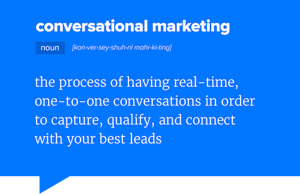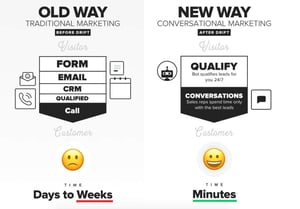Conversation is the Thread of Human Connection in Business
Transcript Follows
Hi, I’m Ed Marsh. I’m joining you from an enormous trade show during the peak of the fall trade show season. Large industrial trade shows have a lot of attributes in common – because the exhibitors and visitors often share many commonalities. In this particular case the show is PackExpo – it’s at Chicago’s McCormick place where it is held every two years. This year the organizers are expecting more than 50,000 visitors and there are more than 1.2MM square feet of exhibit space.
The rate for space at this show is $29/square foot. So booth rental for a small, 20X20 booth would be about $12,000. According to ExhibitsUSA a general rule of thumb planning number is that the total budget for a show will be about 3X the both rental cost. In this case, for a small booth, a substantial and speculative cost of $36,000. That assumes that any equipment that’s built for the show will be sold for a profit, etc.
The point is, it’s expensive. It’s common for industrial companies to build their marketing budget around 3-4 shows/year and a few magazine ads. (It’s worth noting that that’s a far cry from the 3-5% of revenue that most suggest is a reasonable marketing budget for an industrial manufacturer.) But back to the show…
And I hear from one exhibitor after another that the number and quality of leads is declining. Many folks tell me that shows are changing – after all, nobody can just walk a 1.2MM square foot show looking for inspiration.
BUT…shows are strong and many are actually growing. That begs the question, why?
Download our free guide with 17 tips to improve your trade show impact
If they’re very expensive, and not a great lead generation source, why do companies feel compelled to participate? Or said differently, if they’re not getting as much lead value as they used to, why do they take their sales force out of the field for a week and incur the expense?
The answer’s pretty simple.
It’s a human connection.
 People like knowing who they’re doing business with. Sure there’s an element of touching and feeling of products, and there’s the ability to bring multiple members of a buying team to look at 4 or 5 potential solutions very efficiently. But the trade show experience is about connecting person to person – and I have manufacturers routinely say, we didn’t get many leads, but we had some great conversations with target accounts.
People like knowing who they’re doing business with. Sure there’s an element of touching and feeling of products, and there’s the ability to bring multiple members of a buying team to look at 4 or 5 potential solutions very efficiently. But the trade show experience is about connecting person to person – and I have manufacturers routinely say, we didn’t get many leads, but we had some great conversations with target accounts.
You might even call it conversational marketing.
That’s the core of business in many ways – and it’s one that folks lament is too often overlooked with today’s emphasis on websites and digital.
But, as I stand here with this bustle of activity in the background, I’m struck by how conversational marketing is being reintroduced to the digital world of industrial B2B marketing, sales and service. It stands to reason that if someone who’s interested in buying capital equipment comes to a trade show to interact personally with sellers, that they’d appreciate the ability to do that online too - and it’s one of those “smack your forehead” kinds of moments when you realize that it should have been blindingly obvious….but it wasn’t. That's the potential opportunity with conversational marketing.
I speak frequently about changing buyer behaviors, and how the internet has enabled them. Sellers frequently complain that buyers hide in the shadows of the internet, creep on websites and deliberately avoid contacting the seller.
But here’s the question for you - Is it the buyers fault? Or is it the sellers? Who’s created a “contact us” form with 17 questions on the last page on their website – and then relentlessly hunts down anyone determined enough to submit it?
Buyers are just reacting rationally. Why would they voluntarily subject themselves to that experience – the absurd form, or dodging the formulaic voice mails and automated emails?
The irony is that as sellers complain about anonymous buyers, they’re in fact forcing buyers to behave that way.
 Kudos to the folks at Drift for pushing the dots close enough together that it’s helped lots of us see the opportunity in conversational marketing. They’ve taken a Live chat base and completely enriched it to enable real-time digital dialog. They’ve added tools including personalization, rapidly evolving chat bots, conversational landing pages, integrated sales rep calendars, ABM or account based marketing tools, native integrations with other elements of the common digital marketing tech stack, and even email integrated into playbooks.
Kudos to the folks at Drift for pushing the dots close enough together that it’s helped lots of us see the opportunity in conversational marketing. They’ve taken a Live chat base and completely enriched it to enable real-time digital dialog. They’ve added tools including personalization, rapidly evolving chat bots, conversational landing pages, integrated sales rep calendars, ABM or account based marketing tools, native integrations with other elements of the common digital marketing tech stack, and even email integrated into playbooks.
As a Drift partner I’m able to watch this conversational marketing evolution from a different perspective and it’s clear to me that there’s a really interesting opportunity for traditional industrial manufacturers to bridge a technology gap.
These companies believe in working person to person – belly button to belly button. Trade shows and meetings on factory floors are how things are done. That’s in conflict with stagnant websites. Sure, websites useful to research information, but they’re unsatisfactory for both buyers and sellers who want to have a real-time dialog.
Drift’s tool kit for conversational marketing, conversational sales and conversational service could be a leapfrog technology. In other words, like many developing countries skipped landline phones moving straight to mobile, I think when B2B industrials discover this opportunity they’ll simply skip some of the interim website practices.
Certainly there’s some learning around conversational marketing and some adaptation required.
Many folks hesitate about the live chat experience. They don’t realize that we can route by the industry, size, location or account owner of a visitor – or by their status as an anonymous prospect, known prospect, target account, customer or more.
 They also might not realize how advanced chat bots are – and how they streamline capturing visitor info while simultaneously accelerating lead qualification. And they have no idea how simple it makes it for qualified visitors to schedule an initial call with the proper sales rep – all in just moments without days of follow up and back and forth.
They also might not realize how advanced chat bots are – and how they streamline capturing visitor info while simultaneously accelerating lead qualification. And they have no idea how simple it makes it for qualified visitors to schedule an initial call with the proper sales rep – all in just moments without days of follow up and back and forth.
I’ve had people worry about staff to manage incoming chat. My wise guy response is whether they’d manage to figure out how to answer an increase in qualified buyers calling by phone. The answer is "of course.” So the hesitation about chat inquiries is really just a different method. They also often aren’t aware of how easy it is to route to groups in marketing, sales or even service, or how after hours and off line routing can step in quickly.
It’s always interesting when I see a traditional B2B industrial company suddenly “get it.” They realize how conversational marketing in business and chat will support sales, drive leads and provide a welcome opportunity for both buyer and visitor to connect real time – just as they value so much about the trade show experience. Add in the experience it provides for customers too – simple, on demand easy access to knowledge base and service resources, and it becomes a simple yes.
Maybe it’s time for you to replicate the valued trade show experience on line – for all your website visitors - using conversational marketing!
Want to learn more about how conversational marketing might help your biz? Just run with the bot. Let's schedule a brief call.
Conversational Marketing as Part of Your Sales Tech Stack
 Your marketing and sales tech stack should include a conversational marketing app, integrated with thoughtful approaches on specific pages with specific goals. Drift is one option, but it is increasingly focused on the enterprise market. HubSpot's chat app has matured significantly and is a splendid option for most mid-size industrial manufacturers.
Your marketing and sales tech stack should include a conversational marketing app, integrated with thoughtful approaches on specific pages with specific goals. Drift is one option, but it is increasingly focused on the enterprise market. HubSpot's chat app has matured significantly and is a splendid option for most mid-size industrial manufacturers.
To learn more, download this guide to building a great sales tech stack.
More on the Evolution of Conversational Marketing and Harnessing Real-Time Dialogues for Business Success
Conversational marketing answers many of today's market expectations. It's the perfect form of personalization and connection in a world often dominated by impersonal digital interactions. Conversational marketing, a strategy rooted in fostering natural, engaging conversations, has transformed how businesses interact with their customers and prospects - because it mirrors the way they always have in person.
Crafting a Conversational Marketing Strategy
A successful conversational marketing strategy hinges on its ability to initiate and sustain meaningful dialogues. It's not just about responding to customer inquiries; it's about nurturing a continuous and engaging conversation. This approach helps businesses understand their customers on a deeper level, gathering valuable customer data in the process. By analyzing these interactions, companies can tailor their offerings and communication to meet the unique needs of their target audience.
Real-Time Conversations: The Heart of Engagement
The essence of conversational marketing lies in its real-time nature. Unlike traditional marketing channels, it allows for immediate and dynamic interactions. This immediacy is crucial in today's fast-paced world, where customers expect quick and efficient responses. Whether it's through chatbots or live agents, real-time conversations facilitate a smoother customer journey, enhancing customer engagement and satisfaction, improving visitor to lead conversion rates, shortening the path to sales meetings and increasing the number of qualified leads.
Conversational Marketing Examples: Success Stories
Several industrial brands have leveraged conversational marketing to elevate their customer relationships. By implementing conversational marketing platforms, they've transformed their sales process, making it more interactive and customer-centric. These platforms enable sales reps to engage with both existing customers and potential customers in a more personalized manner, effectively shortening sales cycles and improving the sales funnel.
In many of these cases initial executive skepticism quickly evaporated when senior level buying personas at companies that matched the ideal customer profile, engaged on the site. Looking at browsing history, they'd been on the site anonymously in the past, never filled out a form, but finally converted when a chat option was available.
Benefits of Conversational Marketing
The benefits of conversational marketing are manifold. It not only enhances customer communication but also provides valuable insights into customer preferences and behavior. This intelligence can be used to refine marketing and sales strategies, ensuring they resonate more effectively with the intended audience. Additionally, conversational marketing strengthens customer relationships, fostering loyalty and trust. And it's great for industrial sales teams because it helps them connect immediately and personally with prospects who might have just researched anonymously if chat wasn't available.
Inbound Marketing and Conversational Marketing: A Synergistic Relationship
Conversational marketing dovetails seamlessly with inbound marketing strategies. By integrating conversational elements into an inbound marketing strategy, businesses can attract, engage, and delight customers more effectively. This integrated approach ensures a more holistic and customer-focused marketing strategy, aligning with the modern customer's expectations.
Implementing Conversational Marketing: Key Considerations
To implement conversational marketing effectively, businesses must choose the right conversational marketing platforms. These platforms should offer flexibility, scalability, and integration with existing marketing channels. Training sales reps to effectively use these tools is also crucial, as their proficiency directly impacts the quality of customer interactions.
The conversational marketing app should work from the CRM and marketing automation database to support personalization.
Sales Process Reinvention: Conversational Marketing's Role
Conversational marketing has the potential to revolutionize the sales process. By facilitating more natural and engaging interactions, it allows sales reps to understand and address the needs of prospective customers more effectively. This leads to a more informed and customer-centric sales approach, ultimately driving better sales outcomes.
Nurturing Customer Relationships through Conversational Marketing
At the core of conversational marketing is the nurturing of long-term customer relationships. By engaging in meaningful dialogues, businesses can build a rapport with their customers, turning them into brand advocates. This ongoing engagement keeps customers invested and interested, increasing the likelihood of repeat business and referrals. Chat provides existing customers fast access to the resources they need.
Looking Ahead: The Future of Conversational Marketing
As we look to the future, the role of conversational marketing in business is set to grow even more significant. With advancements in AI and machine learning, conversational marketing platforms will become even more sophisticated, enabling more nuanced and human-like interactions. The challenge for businesses will be to balance automation with the human touch, ensuring that customer engagement remains personal and genuine.
It may not feel natural, but conversational marketing represents a paradigm shift in how businesses communicate with their customers. It's not just a marketing strategy; it's a commitment to genuine, customer-centric dialogues. By embracing conversational marketing, businesses can forge stronger connections with their customers, drive sales, and stay ahead in the competitive landscape. Conversational marketing, with its focus on real-time conversations and customer data, is more than a trend—it's the future of customer engagement.


